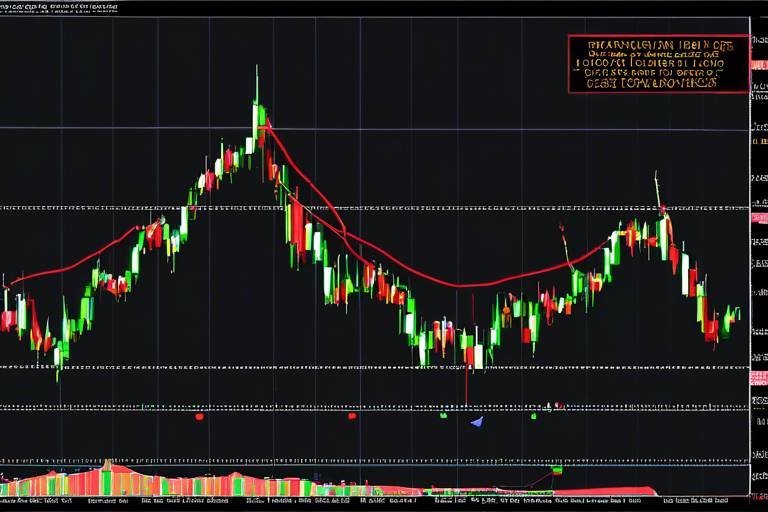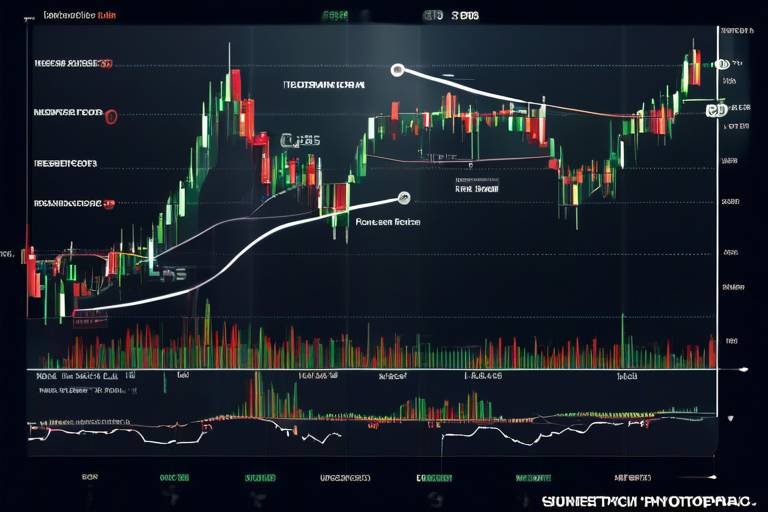How to Identify Market Reversals Using Technical Analysis
Market reversals are one of the most exciting phenomena in the world of trading. Imagine you're on a roller coaster, climbing to the peak, and suddenly, you realize you're about to plunge downwards. That’s the essence of a market reversal—a shift in direction that can either make or break your trading strategy. Understanding how to identify these reversals is essential for any trader looking to capitalize on price movements and manage risks effectively. In this article, we will explore effective methods to recognize market reversals through technical analysis, providing insights into various indicators, patterns, and strategies that can enhance your trading decisions.
Market reversals signal a change in the trend direction, much like the tides shifting in the ocean. Recognizing these shifts is crucial for traders as they present opportunities to capitalize on price movements and manage risks effectively. A reversal can occur at any time, and the ability to spot these moments can mean the difference between profit and loss. Think of it as catching a wave before it breaks; if you're quick enough, you can ride it to success. Reversals can be classified into two main categories: bullish reversals, which indicate a potential upward trend, and bearish reversals, which suggest a downward trend. By understanding how to identify these signals, you can position yourself advantageously in the market.
Various technical indicators aid in identifying potential market reversals. These tools act like a compass, guiding traders through the often turbulent seas of market fluctuations. Some of the most popular indicators include Moving Averages, the Relative Strength Index (RSI), and the Moving Average Convergence Divergence (MACD). Each of these indicators has its own unique characteristics and can be used in different ways to analyze price trends. By utilizing a combination of these indicators, traders can gain a more comprehensive view of market conditions and make informed decisions. Let’s dive deeper into each of these essential tools.
Moving Averages smooth out price data, helping traders identify trends and reversals. They act as a moving filter, allowing you to see the underlying trend without the noise of daily price fluctuations. There are different types of moving averages, each serving a unique purpose in detecting potential market shifts. The two most common types are the Simple Moving Average (SMA) and the Exponential Moving Average (EMA). Understanding their differences and applications can significantly enhance your trading strategies.
The Simple Moving Average is a basic indicator that calculates the average price over a specific period. For example, a 50-day SMA takes the average closing price of the last 50 days. This indicator is straightforward and provides a clear view of the trend direction. However, it may lag behind the market, which means it can sometimes signal a reversal too late. Traders often use it in conjunction with other indicators to confirm potential trends and reversals.
The Exponential Moving Average gives more weight to recent prices, making it more responsive to new information. This feature allows the EMA to react more quickly to price changes, which can be particularly useful in fast-moving markets. By observing crossovers between the EMA and the price line, traders can identify potential reversal points. For instance, when the price crosses above the EMA, it may signal a bullish reversal, while a cross below may indicate a bearish reversal.
The Relative Strength Index is a momentum oscillator that measures the speed and change of price movements. It ranges from 0 to 100 and is typically used to identify overbought or oversold conditions in the market. An RSI above 70 suggests that a security may be overbought, indicating a potential bearish reversal, while an RSI below 30 indicates that it may be oversold, signaling a potential bullish reversal. By incorporating the RSI into your trading strategy, you can better gauge market sentiment and anticipate possible trend changes.
Chart patterns are visual representations of price movements that can indicate market reversals. They are like road signs on your trading journey, guiding you toward potential opportunities. Some key patterns to watch for include Head and Shoulders, Double Tops, and Double Bottoms. Each of these patterns has its own unique formation and significance in predicting market shifts. Understanding these patterns can enhance your ability to spot reversals and make informed trading decisions.
The Head and Shoulders pattern is a reliable indicator of trend reversal. This pattern consists of three peaks: a higher peak (the head) between two lower peaks (the shoulders). When this formation appears, it often signals a shift from bullish to bearish sentiment. Recognizing this pattern can provide traders with a valuable opportunity to enter short positions before the market declines.
Double Tops and Bottoms are critical reversal patterns that signify potential trend changes. A Double Top occurs when the price reaches a high point twice, failing to break through the resistance level, while a Double Bottom forms when the price hits a low point twice, indicating support. Identifying these patterns can help traders anticipate market reversals and adjust their strategies accordingly.
Volume plays a vital role in confirming market reversals. Analyzing trading volume can provide insights into the strength of a reversal signal. For instance, a price reversal accompanied by high volume is generally more reliable than one with low volume. Understanding the relationship between price movements and volume can enhance your trading effectiveness.
Volume spikes often precede significant price movements, making them essential for identifying reversals. A sudden increase in volume can indicate strong buying or selling interest, signaling that a reversal may be imminent. By monitoring volume changes in relation to price action, traders can gain valuable insights into market dynamics.
Volume divergence occurs when price movements do not align with volume trends, indicating potential reversals. For example, if the price is making new highs while volume is declining, it may suggest weakening momentum and a possible bearish reversal. Spotting and utilizing volume divergence in trading strategies can provide a significant edge in identifying market shifts.
- What is a market reversal? A market reversal is a change in the direction of a price trend, indicating a shift from bullish to bearish or vice versa.
- How can I identify a market reversal? You can identify a market reversal using technical indicators like Moving Averages, RSI, and chart patterns such as Head and Shoulders or Double Tops and Bottoms.
- Why is volume important in identifying reversals? Volume provides insights into the strength of a price movement. A reversal accompanied by high volume is generally more reliable than one with low volume.

Understanding Market Reversals
Market reversals are like those unexpected plot twists in your favorite movie; they can change the entire narrative of price movements in trading. Recognizing these shifts is crucial for traders because they present golden opportunities to capitalize on price movements while effectively managing risks. Imagine you're on a roller coaster, climbing to the peak and suddenly, it takes a sharp turn downwards. That’s a market reversal! It indicates a significant change in the trend direction, which can either be a shift from a bullish trend to a bearish trend or vice versa.
Understanding market reversals involves a keen eye for detail and a solid grasp of technical analysis. Traders need to be aware of various factors that contribute to these reversals, including economic indicators, market sentiment, and external events. For instance, a sudden change in economic policy or unexpected news can trigger a reversal that catches many off guard. This is why it’s essential to stay informed and utilize technical tools to spot these shifts before they happen.
Moreover, market reversals can be categorized into two main types: trend reversals and continuation patterns. Trend reversals occur when the price changes direction after a sustained movement, while continuation patterns suggest that the price will continue in the same direction after a brief pause. Understanding these distinctions can help traders make informed decisions about when to enter or exit trades.
To enhance your ability to identify market reversals, it’s beneficial to combine various technical analysis methods. For example, using indicators like Moving Averages alongside chart patterns can provide a clearer picture. When these tools align, the chances of accurately predicting a reversal increase significantly. This synergy between different indicators is akin to having multiple perspectives on a complex issue — it enriches your understanding and improves your decision-making.
In conclusion, grasping the concept of market reversals is vital for any trader looking to enhance their trading strategy. By recognizing the signs of a potential reversal, you can position yourself to take advantage of market movements, ultimately leading to more successful trades. Remember, in the world of trading, timing is everything, and being able to identify these reversals can set you apart from the crowd.

Key Technical Indicators
When it comes to identifying market reversals, having the right tools at your disposal is essential. Technical indicators serve as your eyes and ears in the market, helping you decipher the complex dance of price movements. These indicators are like a compass for traders, guiding them through the fog of uncertainty. Let's dive into some of the most popular technical indicators that can enhance your trading decisions and help you spot those crucial turning points in the market.
One of the most widely used indicators is the Moving Average. This tool smooths out price data over a specified period, making it easier to identify trends and potential reversals. There are several types of moving averages, each with its unique characteristics. For instance, the Simple Moving Average (SMA) calculates the average price over a set number of periods, while the Exponential Moving Average (EMA) gives more weight to recent prices, making it more responsive to new information. Understanding these differences can significantly impact how you interpret market signals.
| Indicator | Description |
|---|---|
| Simple Moving Average (SMA) | Averages prices over a specific period, useful for identifying overall trends. |
| Exponential Moving Average (EMA) | Gives more weight to recent prices, making it quicker to respond to market changes. |
Another critical indicator is the Relative Strength Index (RSI). This momentum oscillator measures the speed and change of price movements on a scale from 0 to 100. An RSI value above 70 typically indicates that an asset is overbought, while a value below 30 suggests it is oversold. These thresholds can signal potential reversals, offering traders valuable insights into when to enter or exit positions. The beauty of the RSI lies in its simplicity; it provides a quick snapshot of market sentiment and can be a game-changer in your trading strategy.
Lastly, let’s not overlook the importance of Volume in confirming market reversals. Volume analysis can provide insights into the strength behind price movements. For instance, a price increase accompanied by a significant volume spike typically indicates strong buying interest, suggesting that the trend may continue. Conversely, if a price rise occurs with low volume, it could be a sign of weakness, hinting at a potential reversal. Understanding how to interpret volume changes in relation to price action can elevate your trading game.
In summary, mastering these key technical indicators—Moving Averages, RSI, and Volume Analysis—can significantly enhance your ability to identify market reversals. Each indicator has its strengths and weaknesses, and using them in conjunction can provide a more comprehensive view of the market landscape. So, the next time you’re analyzing price charts, remember that these tools are your allies in navigating the ever-changing tides of the market.
- What is a market reversal? A market reversal is a change in the direction of the price trend, indicating a potential shift from bullish to bearish or vice versa.
- How do I use Moving Averages to identify reversals? Moving Averages can help you spot trends by smoothing out price data. Look for crossovers between different types of MAs as potential reversal signals.
- What does an RSI above 70 mean? An RSI above 70 indicates that an asset may be overbought, suggesting a potential price reversal or correction.
- Why is volume important in technical analysis? Volume provides context to price movements. High volume during a price change often confirms the strength of that move, while low volume may indicate weakness.

Moving Averages
Moving averages are one of the most widely used tools in technical analysis, and for good reason! They help traders smooth out price data over a specific time frame, making it easier to identify trends and potential reversals. Think of moving averages as a pair of glasses that allow you to see through the noise of daily price fluctuations. By focusing on the average price over a set period, you can get a clearer picture of the market's direction.
There are two main types of moving averages that traders often use: the Simple Moving Average (SMA) and the Exponential Moving Average (EMA). Each of these has its own unique characteristics and applications, which can significantly impact trading strategies. Let’s dive deeper into these two types to understand how they can signal potential market shifts.
The Simple Moving Average (SMA) is the most basic form of moving average. It calculates the average price over a specified number of periods, which could be days, weeks, or even months. For example, a 10-day SMA takes the closing prices of the last 10 days, adds them up, and divides by 10. This straightforward calculation makes it a great starting point for traders looking to identify trends.
However, while the SMA is beneficial for spotting trends, it can lag behind the price movements, especially during volatile market conditions. This lag can sometimes lead to late signals, which is why many traders prefer the EMA for more reactive trading strategies.
On the other hand, the Exponential Moving Average (EMA) gives more weight to recent prices, making it more sensitive to new information. This characteristic allows the EMA to respond more quickly to price changes, which can be crucial during market reversals. For instance, if the price suddenly spikes, the EMA will adjust more rapidly than the SMA, potentially alerting traders to a reversal sooner.
To illustrate the differences between the SMA and EMA, consider the following table:
| Feature | Simple Moving Average (SMA) | Exponential Moving Average (EMA) |
|---|---|---|
| Calculation Method | Average of prices over a set period | Weighted average that prioritizes recent prices |
| Responsiveness | Slower to respond to price changes | Faster to react to market movements |
| Use Case | Long-term trend analysis | Short-term trading strategies |
In practice, many traders use both the SMA and EMA together to create a more comprehensive trading strategy. For example, a common approach is to look for crossovers between the two moving averages. When the EMA crosses above the SMA, it can signal a potential bullish reversal, while a crossover in the opposite direction might indicate a bearish trend. This technique can help traders make informed decisions based on the interplay between short-term and long-term trends.
Ultimately, moving averages are powerful tools that can enhance your trading strategy. By understanding how to use both the SMA and EMA effectively, you can better identify market reversals and make more informed trading decisions. Just remember, while moving averages can provide valuable insights, they are just one piece of the puzzle. Always consider other indicators and market conditions to confirm your trading signals!

Simple Moving Average (SMA)
The is one of the most fundamental tools in a trader's arsenal, representing the average price of an asset over a specific period. Imagine you're tracking the average temperature over a week; just like how you sum up daily temperatures and divide by seven, the SMA does the same for price data. By smoothing out price fluctuations, the SMA helps traders identify the overall trend direction, making it easier to spot potential market reversals.
When traders look at a chart, the SMA provides a clear visual representation of the average price over time. For instance, a 50-day SMA takes the average closing prices of the last 50 days, creating a line that moves along the price chart. This line can act as a support or resistance level, guiding traders on when to enter or exit trades. The beauty of the SMA lies in its simplicity; however, it’s essential to understand its limitations as well. Since it’s based on historical data, it can lag behind current price movements. This lag can sometimes lead to missed opportunities, especially in fast-moving markets.
To better understand the SMA's application, let’s consider how it can be used in conjunction with other indicators. For example, when the price crosses above the SMA, it may suggest a bullish trend, while a crossover below could indicate a bearish trend. This crossover can serve as a potential signal for traders to make decisions. Here’s a simple table illustrating different SMA periods and their typical uses:
| SMA Period | Typical Use |
|---|---|
| 10 days | Short-term trading, capturing quick price moves |
| 50 days | Medium-term trends, balancing noise and trend |
| 200 days | Long-term trends, identifying overall market direction |
In summary, the Simple Moving Average is a powerful indicator that can enhance trading strategies by providing clarity on price trends. While it may not be foolproof, understanding how to effectively utilize the SMA can significantly improve your ability to identify potential market reversals. So, the next time you analyze a chart, keep an eye on the SMA; it might just reveal the insights you need to make informed trading decisions.
- What is the difference between SMA and EMA? The Exponential Moving Average (EMA) gives more weight to recent prices, making it more responsive than the SMA, which treats all prices equally.
- How do I choose the right SMA period? The choice of SMA period depends on your trading strategy; shorter periods are better for day trading, while longer periods are suited for long-term investments.
- Can I use SMA for all types of assets? Yes, SMA can be applied to various assets, including stocks, forex, and commodities, making it a versatile tool in technical analysis.

Exponential Moving Average (EMA)
The is a powerful tool in the realm of technical analysis, particularly when it comes to identifying market reversals. Unlike the Simple Moving Average (SMA), which treats all data points equally, the EMA places greater emphasis on the most recent prices. This characteristic makes the EMA more responsive to new information, allowing traders to detect potential changes in market trends more swiftly. Imagine trying to catch a wave; the EMA is like a surfboard that adjusts to the shifting tides, giving you the edge to ride the market’s movements effectively.
To calculate the EMA, traders use a specific formula that incorporates the previous EMA value along with the current price. This calculation results in a smoother average that reacts more quickly to price changes. Here’s a simplified version of the formula:
EMA (Current Price x Multiplier) + (Previous EMA x (1 - Multiplier)) Multiplier 2 / (N + 1)
In this formula, N represents the number of periods over which you want to calculate the EMA. The shorter the period, the more sensitive the EMA becomes to price fluctuations, making it a valuable asset for short-term traders. Conversely, a longer period EMA will provide a more stable average, which can be beneficial for long-term strategies.
One of the most effective ways to utilize the EMA for identifying market reversals is through the concept of crossovers. A bullish crossover occurs when a shorter-term EMA crosses above a longer-term EMA, suggesting a potential upward trend. On the other hand, a bearish crossover happens when a shorter-term EMA crosses below a longer-term EMA, indicating a possible downward trend. These crossovers can serve as strong signals for traders to enter or exit positions.
| Type of Crossover | Signal |
|---|---|
| Bullish Crossover | Potential Uptrend |
| Bearish Crossover | Potential Downtrend |
Furthermore, the EMA can also be used in conjunction with other indicators to enhance its effectiveness. For instance, combining the EMA with the Relative Strength Index (RSI) can provide a more comprehensive view of market conditions. If the EMA indicates a bullish trend while the RSI shows overbought conditions, it may be wise for traders to exercise caution and consider potential reversals.
In summary, the Exponential Moving Average is not just a number on a chart; it’s a dynamic tool that offers insights into market behavior. By understanding how to effectively apply the EMA in your trading strategies, you can better position yourself to identify market reversals and seize opportunities as they arise. So, are you ready to ride the waves of the market with the EMA as your guide?
- What is the main difference between SMA and EMA? The main difference is that EMA gives more weight to recent prices, making it more responsive to new information compared to SMA.
- How do I choose the right period for EMA? The choice of period depends on your trading strategy; shorter periods are more sensitive and suitable for short-term trading, while longer periods provide stability for long-term strategies.
- Can I use EMA with other indicators? Absolutely! EMA works well with other indicators like RSI or MACD to provide a deeper understanding of market trends and potential reversals.

Relative Strength Index (RSI)
The is a powerful momentum oscillator that traders use to gauge the speed and change of price movements. Developed by J. Welles Wilder Jr., this indicator ranges from 0 to 100 and is primarily used to identify overbought or oversold conditions in a market. When the RSI reaches extreme levels—typically above 70 or below 30—it can signal a potential reversal in price direction, making it a crucial tool for traders looking to capitalize on market shifts.
Understanding the RSI is akin to having a compass in the turbulent seas of trading. Imagine navigating through unpredictable waters; the RSI helps you determine whether the market is too hot or too cold. When the RSI is above 70, it suggests that an asset may be overbought, meaning that prices have risen too quickly and might be due for a correction. Conversely, an RSI below 30 indicates that an asset may be oversold, presenting a potential buying opportunity as prices could bounce back. This ability to spot extremes is what makes the RSI an invaluable part of a trader's toolkit.
To further illustrate its practical application, let’s take a look at how to interpret the RSI values:
| RSI Value | Interpretation |
|---|---|
| 0 - 30 | Oversold conditions, potential buying opportunity |
| 30 - 70 | Neutral range, market is stable |
| 70 - 100 | Overbought conditions, potential selling opportunity |
However, relying solely on the RSI can lead to pitfalls. It’s essential to combine this indicator with other technical analysis tools to confirm signals. For instance, using the RSI in conjunction with Moving Averages or Chart Patterns can provide a more comprehensive view of market conditions. When the RSI indicates an overbought condition, and you also see a bearish reversal pattern forming on the chart, it strengthens the case for a potential market reversal.
Moreover, traders should also be aware of the concept of divergence, which occurs when the price of an asset moves in the opposite direction of the RSI. For example, if prices are making new highs while the RSI is making lower highs, this divergence can signal that the current trend is losing momentum and a reversal may be imminent. Recognizing these divergences can give traders an edge in anticipating market movements.
In summary, the Relative Strength Index is more than just a number; it’s a vital component of a trader’s strategy. By understanding how to read the RSI and incorporating it with other indicators and patterns, traders can significantly enhance their decision-making process and improve their chances of successfully identifying market reversals.
- What is the best RSI setting for trading? While the default setting is 14 periods, many traders adjust this based on their specific strategy or the asset they are trading.
- Can RSI be used for all types of markets? Yes, RSI can be applied to various markets including stocks, forex, and commodities.
- Is RSI a leading or lagging indicator? RSI is considered a leading indicator as it can provide signals before price movements occur.

Chart Patterns to Watch
Chart patterns are like the visual language of the market, speaking volumes about the potential future movements of prices. They are the fingerprints of trading psychology, revealing the collective emotions of buyers and sellers. Recognizing these patterns can be a game-changer for traders, as they often signal key market reversals. Among the various chart patterns, some stand out as particularly reliable indicators of trend changes. Understanding these patterns can empower traders to make informed decisions and capitalize on market opportunities.
One of the most well-known reversal patterns is the Head and Shoulders. This pattern typically forms after an uptrend and is characterized by three peaks: the first peak (left shoulder), the second peak (head), and the third peak (right shoulder). When this pattern is completed, it often signals a bearish reversal. Traders look for confirmation once the price breaks below the neckline, which is drawn by connecting the lows of the pattern. This break can trigger a significant sell-off, making it a crucial point for traders to watch.
On the flip side, the Inverse Head and Shoulders pattern signals a bullish reversal. It consists of three troughs: the left shoulder, the head, and the right shoulder, with the price moving down before reversing. This pattern is particularly appealing to traders looking to enter long positions, as the breakout above the neckline can lead to substantial upward momentum.
Another important pattern to consider is the Double Top, which forms after an uptrend and indicates a potential reversal. This pattern consists of two peaks at roughly the same price level, separated by a trough. The confirmation comes when the price breaks below the trough, signaling that the buyers have lost control, and sellers are taking over. Conversely, the Double Bottom pattern, which appears after a downtrend, signifies a potential bullish reversal. It consists of two troughs at a similar price level, followed by a breakout above the resistance level created by the peaks between the troughs.
In addition to these patterns, traders should also pay close attention to Volume. Volume serves as a confirmation tool for these patterns. For instance, a Head and Shoulders pattern with increasing volume during the formation of the right shoulder can indicate a stronger reversal signal. On the other hand, if the volume decreases as the pattern completes, it may suggest a lack of conviction in the reversal.
In summary, recognizing chart patterns is essential for traders aiming to identify market reversals. Patterns like Head and Shoulders, Double Tops, and Double Bottoms provide valuable insights into market sentiment. By combining these patterns with volume analysis, traders can enhance their decision-making process and increase their chances of success in the ever-changing financial markets.
- What is a chart pattern?
A chart pattern is a recognizable formation created by the price movements of a security on a chart. These patterns help traders predict future price movements based on historical behavior.
- How reliable are chart patterns?
While chart patterns can provide valuable insights, they are not foolproof. Market conditions, news events, and other external factors can impact the reliability of these patterns.
- Can I trade solely based on chart patterns?
While chart patterns are a powerful tool, it's advisable to use them in conjunction with other technical indicators and fundamental analysis for a more comprehensive trading strategy.
- How can I practice identifying chart patterns?
Many trading platforms offer demo accounts where you can practice identifying and trading based on chart patterns without risking real money. Additionally, online resources and courses can help you improve your skills.

Head and Shoulders
The pattern is one of the most recognized and reliable indicators of a trend reversal in technical analysis. Imagine it as a mountain range, where the peaks signify different stages of market sentiment. This pattern forms when the price action creates three distinct peaks: a higher peak (the head) between two lower peaks (the shoulders). Understanding this formation can be a game-changer for traders looking to capitalize on potential shifts in market direction.
To identify a Head and Shoulders pattern, traders typically look for the following characteristics:
- Left Shoulder: This is the first peak, formed after an increase in price, followed by a decline.
- Head: The second peak, which is the highest point, occurs after the price rises again and then falls.
- Right Shoulder: The third peak mirrors the left shoulder but is usually lower than the head, followed by another decline.
Once this pattern is established, it typically signals a shift from a bullish to a bearish trend. Traders often look for confirmation through a break below the neckline, which is drawn by connecting the lows of the left shoulder and the head. This neckline acts as a critical support level, and when the price breaks below it, it confirms the reversal, often leading to a significant price drop.
Understanding the Head and Shoulders pattern is essential, but it’s also crucial to consider the volume accompanying the formation. Ideally, volume should increase during the formation of the head and decrease during the right shoulder, confirming the pattern's validity. If traders notice a spike in volume as the price breaks below the neckline, it adds further confidence to the reversal signal.
In summary, the Head and Shoulders pattern serves as a powerful tool for traders aiming to identify market reversals. By recognizing this pattern and understanding its implications, traders can make more informed decisions, manage risks better, and potentially enhance their profitability in the ever-changing landscape of financial markets.
- What does the Head and Shoulders pattern indicate? It indicates a potential reversal from a bullish trend to a bearish trend.
- How can I confirm a Head and Shoulders pattern? Look for a break below the neckline and consider volume trends for confirmation.
- Are there different types of Head and Shoulders patterns? Yes, there’s an inverse Head and Shoulders pattern that indicates a reversal from bearish to bullish.

Double Tops and Bottoms
The patterns are among the most widely recognized indicators of potential market reversals. These formations occur when the price reaches a certain level twice, creating two peaks or troughs on the chart. Understanding how to identify and interpret these patterns can significantly enhance your trading strategy.
A Double Top pattern typically signals a reversal in an uptrend. It forms when the price rises to a peak, retraces, and then rises again to a similar peak before declining. This pattern indicates that buyers are losing momentum, and sellers are starting to take control. Conversely, the Double Bottom pattern emerges in a downtrend. It occurs when the price falls to a low, rebounds, and then falls again to a similar low before rising. This suggests that sellers are losing strength, and buyers are beginning to step in.
To illustrate these concepts, let’s take a closer look at the characteristics of both patterns:
| Pattern | Formation Characteristics | Market Implication |
|---|---|---|
| Double Top |
|
Potential trend reversal from bullish to bearish |
| Double Bottom |
|
Potential trend reversal from bearish to bullish |
Identifying these patterns involves looking for the following key elements:
- Price Levels: The peaks or troughs should be at approximately the same price level, which indicates strong support or resistance.
- Volume Confirmation: Ideally, there should be an increase in volume during the formation of the second peak or trough, reinforcing the strength of the reversal signal.
- Breakout Point: The breakout occurs when the price moves beyond the neckline, which is the support level for a Double Top and the resistance level for a Double Bottom.
Traders often look for additional confirmation signals, such as other technical indicators or chart patterns, to validate the Double Tops and Bottoms. For instance, a bearish divergence in the Relative Strength Index (RSI) can strengthen the case for a Double Top, while a bullish divergence can enhance the reliability of a Double Bottom.
In summary, mastering the identification of Double Tops and Bottoms can provide traders with valuable insights into potential market reversals. By recognizing these patterns early and combining them with other technical analysis tools, traders can make more informed decisions and improve their chances of success in the markets.
Q1: How reliable are Double Tops and Bottoms in predicting market reversals?
A1: While Double Tops and Bottoms are generally reliable indicators, no pattern is foolproof. It's essential to use them in conjunction with other technical analysis tools for better accuracy.
Q2: What is the best timeframe to look for these patterns?
A2: Double Tops and Bottoms can form on various timeframes, from minutes to daily charts. However, the longer the timeframe, the more significant the reversal signal tends to be.
Q3: Can these patterns occur in any market?
A3: Yes, Double Tops and Bottoms can appear in any financial market, including stocks, forex, and commodities. They are universal patterns that traders across different markets can utilize.

Volume Analysis
When it comes to understanding market reversals, is like the secret sauce that can make your trading strategy more flavorful. Why is volume so important, you might ask? Well, it provides crucial insights into the strength and sustainability of price movements. Think of volume as the heartbeat of the market; when it spikes, it often indicates that something significant is happening beneath the surface. If prices are moving but the volume is low, you might want to proceed with caution. It’s like a quiet storm—looks calm on the surface, but you know there’s a tempest brewing.
One of the key aspects of volume analysis is recognizing volume spikes. These spikes can often precede major price movements, serving as a warning signal for traders to pay attention. For instance, if you notice a sudden increase in volume while the price is approaching a key support or resistance level, it could be a sign that a reversal is imminent. To illustrate this, let’s take a look at a simple table showing how volume can correlate with price changes:
| Volume Level | Price Action | Potential Signal |
|---|---|---|
| Low Volume | Price is stable | Trend may continue |
| Moderate Volume | Price begins to fluctuate | Watch for potential reversal |
| High Volume | Significant price movement | Possible trend reversal |
Another important concept in volume analysis is volume divergence. This occurs when the price movement does not align with the volume trend. For example, if the price is making new highs, but the volume is decreasing, it can indicate a weakening trend and a potential reversal. This divergence acts like a red flag, alerting traders to reconsider their positions. To spot volume divergence, keep an eye on the following:
- Price making new highs with decreasing volume.
- Price making new lows while volume is increasing.
- Consistent volume patterns that contradict price trends.
By incorporating volume analysis into your trading strategy, you can enhance your ability to identify potential market reversals. Remember, volume isn’t just a number; it tells a story about market sentiment and trader behavior. So, the next time you're analyzing a chart, don’t just focus on price—pay attention to the volume as well. It might just give you the edge you need to make more informed trading decisions.
What is the importance of volume in trading?
Volume is critical because it provides insights into the strength of a price move. High volume can indicate strong interest and conviction in a price trend, while low volume may suggest a lack of commitment, making price movements less reliable.
How can I identify volume spikes?
You can identify volume spikes by monitoring trading volume indicators, often available on trading platforms. Look for sudden increases in volume that exceed average levels, especially during significant price movements.
What is volume divergence?
Volume divergence occurs when the price of an asset moves in one direction while the volume moves in the opposite direction. This can signal a potential reversal, as it indicates that the strength behind the price movement is weakening.

Volume Spikes
When it comes to trading, are like the loud sirens of the financial world, signaling that something significant is about to happen. These spikes occur when the trading volume suddenly increases beyond the average levels, often preceding major price movements. Think of it as a crowd gathering at a concert; when the noise level rises, you know something exciting is about to take place. In the trading arena, a volume spike can indicate that traders are either buying or selling aggressively, which can lead to potential market reversals.
Understanding the context of these volume spikes is crucial. For instance, if the price of an asset is rising and you notice a volume spike, it could mean that the uptrend is gaining momentum. Conversely, if a significant volume spike occurs while the price is falling, it might indicate panic selling, which can often lead to a reversal. Traders should always consider volume spikes in conjunction with price action to get a clearer picture of market sentiment.
To better illustrate the importance of volume spikes, let’s look at a simple table that summarizes their implications:
| Volume Spike Scenario | Possible Interpretation |
|---|---|
| Price Rising + Volume Spike | Uptrend Strengthening |
| Price Falling + Volume Spike | Panic Selling or Reversal Signal |
| Price Consolidating + Volume Spike | Potential Breakout or Breakdown |
It's also essential to consider the duration of the volume spike. A brief spike may not carry the same weight as a sustained increase in volume. For instance, if you see a sudden spike that lasts only a few minutes, it might be a false signal, often referred to as a "blip." On the other hand, a sustained increase in volume over several hours or days can be a strong indicator of a trend change.
In conclusion, volume spikes are a powerful tool in the trader’s toolbox. By keeping an eye on these spikes and interpreting them correctly, traders can significantly enhance their ability to identify potential market reversals. So, the next time you see a volume spike, don’t just brush it off—take a closer look and see what story the market is trying to tell you!
- What is a volume spike? A volume spike is a sudden increase in trading volume that often precedes significant price movements.
- How can I identify a volume spike? You can identify a volume spike by comparing current volume levels to historical averages; a spike occurs when the current volume significantly exceeds the average.
- Are volume spikes always reliable indicators of market reversals? While volume spikes can indicate potential reversals, they should be analyzed in conjunction with price action and other indicators for confirmation.

Volume Divergence
Volume divergence is a fascinating concept in technical analysis that can provide traders with crucial insights into potential market reversals. It occurs when the price of an asset moves in one direction while the trading volume moves in the opposite direction. This disconnection can signal that the current trend is losing strength and that a reversal may be imminent. Imagine a car speeding down a highway, but the engine is sputtering—this is akin to what happens in volume divergence. The price may be moving up, but if the volume is decreasing, it suggests that fewer participants are driving the price higher, hinting at a possible slowdown.
To better understand volume divergence, let's break it down into two primary types:
- Positive Divergence: This occurs when the price makes a new low, but the volume does not confirm this move with a corresponding increase. It suggests that selling pressure is weakening, potentially indicating a bullish reversal.
- Negative Divergence: Conversely, this happens when the price reaches a new high, but the volume decreases. This scenario implies that buying enthusiasm may be waning, signaling a possible bearish reversal.
Traders can leverage volume divergence in conjunction with other indicators to enhance their trading strategies. For instance, if you notice a negative divergence while the Relative Strength Index (RSI) is in overbought territory, it could reinforce the idea that a price reversal is on the horizon. This combination of signals can be a powerful tool in a trader's arsenal.
To visualize this concept, consider the following hypothetical table illustrating how volume divergence might appear on a price chart:
| Time Frame | Price Movement | Volume Movement | Divergence Type |
|---|---|---|---|
| Week 1 | Price rises to $100 | Volume increases to 1,000 | None |
| Week 2 | Price rises to $110 | Volume decreases to 800 | Negative Divergence |
| Week 3 | Price drops to $105 | Volume increases to 1,200 | Positive Divergence |
In this example, the negative divergence in Week 2 suggests that the price increase may not be sustainable, while the positive divergence in Week 3 indicates a potential reversal opportunity. As traders, understanding these nuances can significantly enhance our decision-making process.
In summary, volume divergence is a key indicator that should not be overlooked. By paying close attention to the relationship between price and volume, traders can gain valuable insights into market dynamics and improve their chances of successfully identifying reversals.
Q: How can I spot volume divergence on a trading chart?
A: Look for instances where the price is moving in one direction while the volume trends in the opposite direction. Using indicators like the RSI or MACD alongside volume can help confirm these divergences.
Q: Is volume divergence applicable to all markets?
A: Yes, volume divergence can be observed across various markets, including stocks, forex, and cryptocurrencies. The principles remain the same, although the specific characteristics of each market may affect the signals.
Q: Can volume divergence predict the exact timing of a reversal?
A: While volume divergence is a strong signal of potential reversals, it cannot predict the exact timing. It is best used in conjunction with other technical indicators and analysis methods to make informed trading decisions.
Frequently Asked Questions
- What are market reversals?
Market reversals are significant changes in the direction of price trends. They signal a shift from an uptrend to a downtrend or vice versa, presenting traders with opportunities to make strategic decisions.
- How can I identify market reversals using technical analysis?
You can identify market reversals by using various technical indicators such as Moving Averages, the Relative Strength Index (RSI), and observing specific chart patterns like Head and Shoulders or Double Tops and Bottoms. Each tool offers unique insights into price movements.
- What is the difference between Simple Moving Average (SMA) and Exponential Moving Average (EMA)?
The Simple Moving Average (SMA) calculates the average price over a set period, providing a smooth representation of price trends. In contrast, the Exponential Moving Average (EMA) gives more weight to recent prices, making it more responsive to market changes and potential reversals.
- How does the Relative Strength Index (RSI) indicate overbought or oversold conditions?
The RSI is a momentum oscillator that ranges from 0 to 100. An RSI above 70 typically indicates an overbought condition, suggesting a potential reversal downwards, while an RSI below 30 indicates an oversold condition, hinting at a possible upward reversal.
- What are volume spikes and why are they important?
Volume spikes are sudden increases in trading volume that often precede significant price movements. They are crucial for confirming the strength of a reversal signal, as high volume during a price change indicates strong market interest and conviction.
- What is volume divergence and how can it be used in trading?
Volume divergence occurs when the price trend does not align with volume trends, such as when prices rise but volume decreases. This can indicate weakening momentum and potential reversals, allowing traders to adjust their strategies accordingly.



















